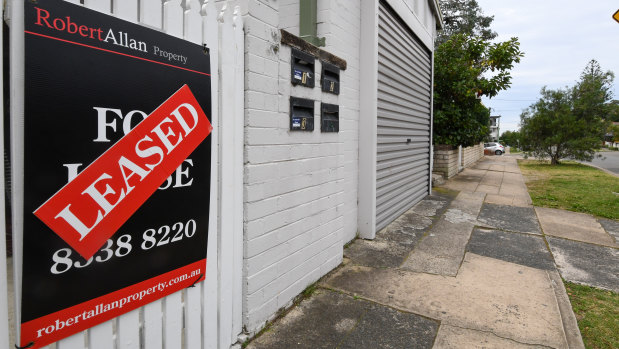
The housing industry fears new home construction will tumble to its lowest levels in a decade as the Reserve Bank drives up interest rates, while tenants have been warned national rents could soar more than 11 per cent over the coming 12 months.
As minutes of the Reserve’s latest board meeting showed it considered hitting borrowers with a 0.5 percentage point lift in rates this month, analysis by St George suggests renters may have to pay an extra $10 billion to their landlords this year in a move that would slow the overall economy.
Higher interest rates are contributing to problems for tenants, with St George predicting another 11.5 per cent jump in rents.Credit:Peter Rae
The RBA has come under fire since its February 7 meeting, when it raised the cash rate by 0.25 percentage points and flagged further increases over the coming months to bring inflation under control. Financial markets expect the cash rate to hit 4.1 per cent by the middle of the year.
At its December meeting, the RBA board discussed keeping rates steady or lifting rates by either a quarter or half a percentage point. By its February meeting, however, talk of a pause was ditched, with the focus on the size of a lift in the cash rate.
The minutes show a strong case was put for a 0.5 percentage point lift.
“The arguments for a 50 basis point increase stemmed from the concern that there had been a pattern of incoming prices and wages data exceeding expectations, and a risk that high inflation would be persistent,” the minutes showed.
“If it did persist, there would be significant costs, including higher interest rates and a larger increase in unemployment later on.
“Relatedly, members observed that the longer inflation stayed high, the greater the risk of price and wage expectations moving higher.”
The case for a 0.25 percentage point rise focused on arguments that inflation might have peaked, that household consumption was likely to soften, as well as uncertainties around the Australian and global economies.
While sticking with the smaller rate rise, the minutes show the bank is increasingly uncertain about the direction of the economy. The word “uncertainty” was used 10 times compared to seven in its December minutes.
One of the key uncertainties is how consumers respond to the bank’s nine consecutive interest rate rises, the most aggressive tightening of monetary policy since the late 1980s.
St George economists Pat Bustamante and Jameson Coombs said housing costs for renters, who account for about a third of the population, were already near record highs before the RBA started lifting rates.
They are forecasting an 11.5 per cent lift in rents through 2023 – after a 10 per cent jump last year – equating to a $10 billion increase in household rent bills.
“This is on top of the $5 billion increase in households’ 2022 rent bill. This is significant,” they said.
“A $10 billion increase in the rent bill of households is equivalent to an average 20 per cent increase in housing costs. These households will likely be required to pull back on spending to meet the higher rental costs. If this occurs, nominal household consumption could be up to 1 per cent lower in 2023 alone.”
And potential home buyers, already struggling as mortgage rates climb, are likely to face a battle to buy a new house over the next two years.
Forecasts by the Housing Industry Association suggest the number of new detached houses is on track to fall to the lowest point since 2012. It is tipping just 96,000 to be built in 2024-25, compared to a peak of 141,000 in 2020-21.
HIA chief economist Tim Reardon said the number of new homes was poised to fall by 8.9 per cent this year and another 12 per cent in 2024. By 2025, just 97,820 detached houses are expected to be built.
He said the RBA’s rate rises, coupled with tighter lending standards imposed by the Australian Prudential Regulation Authority, were sending the housing sector into a downturn.
“The 2022 cash rate increases were sufficient to bring this building boom to an end and further increases in 2023 will accelerate this downturn,” Reardon said.
“It is unfortunate that the RBA appears set to repeat the cycle the building industry experienced after the GFC [global financial crisis]. Following an initial cut to rates, the RBA then increased rates quickly, bringing the building industry to a stall, before being forced to cut rates again to avoid adverse impacts on the wider economy.”
Reardon said macro-prudential regulations, aimed at restricting the amount that people can borrow from a bank, should be loosened.
Borrowing for those with less than a 20 per cent deposit had become more expensive, forcing banks to lend increasingly to those who already had a home, he said.
Cut through the noise of federal politics with news, views and expert analysis from Jacqueline Maley. Subscribers can sign up to our weekly Inside Politics newsletter here.
Most Viewed in Politics
From our partners
Source: Read Full Article
